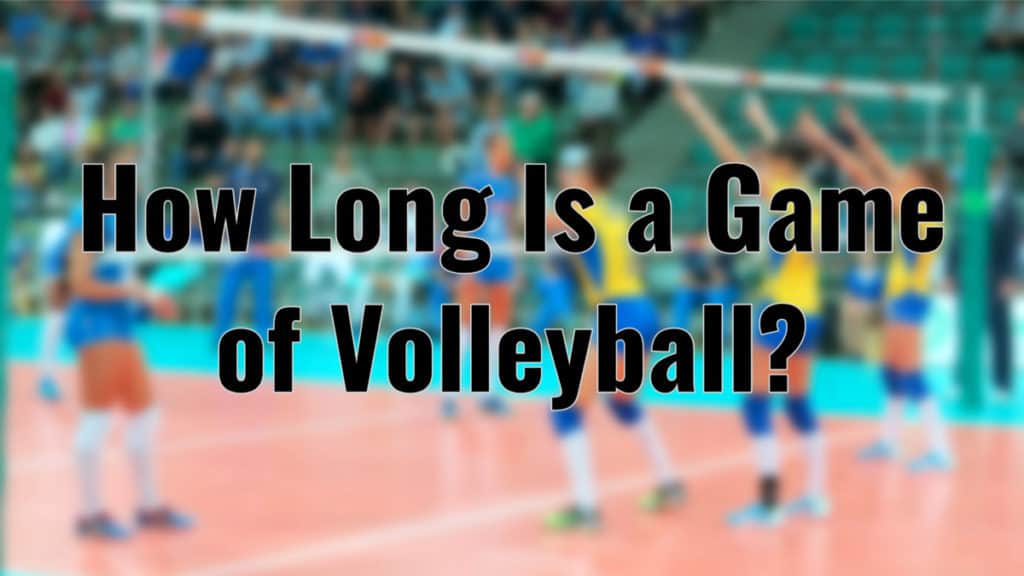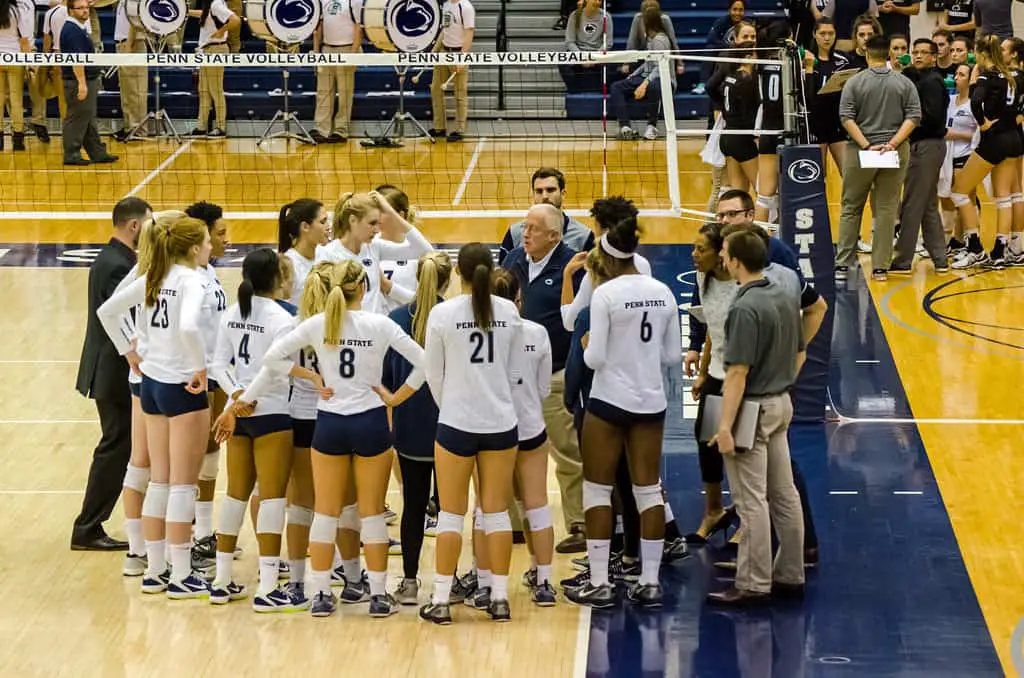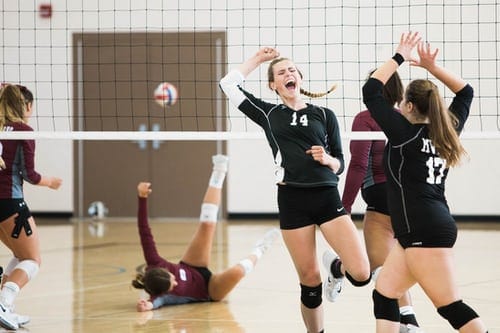
Here you are looking to understand how long a game of volleyball is. Whether you are playing recreationally, competitively, or you will be watching a game of volleyball, it is understandable to wonder what you are getting yourself into.
A typical match of volleyball is played in a best 2-out-of-3 sets. An average set will take about 25 minutes. Using rally scoring, the first team to reach 25 points is declared the winner of the set. A match of volleyball should take between 60 and 90 minutes, including potential timeouts and breaks.
To better understand the length of a volleyball game, let’s explore all the time-consuming elements of a volleyball match. I’ll be breaking down a number of procedures and rules, such as the length of rallies, sets, matches, and timeouts.
How Long Is a Set in Volleyball?
Contrary to other sports like hockey or soccer, volleyball has no restriction on time. The game proceeds until a winner arises by winning the appropriate number of points or sets. Not only that, but the duration of a game can vary greatly in length depending on skill level, rally length, and other game rules.
There are a number of procedural elements to a game of volleyball that can extend the duration of the match, but on average the length of a game in minutes will follow closely the number of points needed to win the set. If the set is to 25 points, the set will take approximately 25 minutes, if the set is to 15 points, the set will take 15 minutes. This is because it is common to see one to two points being earned each minute in a game of volleyball.
Many other factors will influence the duration of a set, such as the skill level. The higher the skill level, the more capable and aggressive each play becomes. The more the players are skilled, the more volleyball will be played at a faster pace. However, even at the top levels, evenly matched opponents can still lengthen the duration of a game as points will still be earned somewhat evenly, forcing the lengthening of a set.
How Many Points Needed to Win a Set?
As mentioned in my initial answer above, a team requires 25 points to win a set. This would mean a team will need to win at least 25 rallies. That being said, volleyball has a rule similar to the deuce rule in tennis. In order to win, this rule requires that a team reach a differential of at least two points at or above 25 (i.e. 26-24). Often, this rule will cap the points at 30 points, which means a team could theoretically win with a final score of 30-29.
The number of sets can also change the number of points needed to win. In the event of a tie-breaker set, the number of points required to win the set will change to 15. For example, in the third match of a 2-out-of-3, the winning team would be the first team to reach 15 points. However, the deuce rule still applies here, requiring a differential of at least two points. In this final set, the points cap is then changed to 20 points.

How Many Sets in a Game of Volleyball?
There are many different competitive settings or format in volleyball that will influence the length of a match. Here are the three most common match formats found in competitive volleyball; the 2-out-of-3, the 3-out-of-5, and the best out of 2.
Match Formats and Their Length
2-Out-of-3
To win a 2-out-of-3, a team must win two sets. The first two sets are played to 25 points. In the event of a third set, the number of points required to win is changed to 15.
The 2-out-of-3 is the common format of matches found in low and medium skill level tournament and competitive settings. This format is more popular at these levels because it allows for a long competition and offers opportunities for each team to explore strategies and adapt to the opposing team.
As mentioned in my initial answer, the average length of a 2-out-of-3 is between 60 and 90 minutes.
3-Out-of-5
To win a 3-out-of-5, a team must win three sets. The first four sets are played to 25 points. In the event of a firth set, the number of points required to win is changed to 15.
This format is used in most high-level competitions, such as college and professional volleyball. Furthermore, most high-school level competitions will also use this format for most tournament or season championship finals.
Just like the 2-out-of-3, this format allows for a greater competition where each team can strategize, learn, and adapt to their opponents as the match progresses. More importantly, this longer format requires endurance and perseverance.
Following my estimate of 25 minutes per set, the average length of a 3-out-of-5 is between 90 and 150 minutes.
Best Out of 2
The best out of 2 is a format where only two sets are played, regardless of who wins. The sets can end at 1 match each or at 2-0. The other difference is that this format requires that the results and points be kept and submitted. In the event of a tie, 1-1, the scoring difference can act as the tie-breaker. For example, the first set is won 25-21 for team A, the second set is won 25-23 for team B. In this scenario, the event/competition organizer can observe that team A scored more points (25+23 = 48 points) than team B (21+25=46), thus declaring team A the winner.
This format is used in some types of tournaments where space and/or time may be issues for the organizers. Knowing that each game will be restricted to two sets, with an average length of 25 minutes per set, allows for the organizers to plan the tournament with more precise time-slots and fewer delays.
Once again, following my estimate of 25 minutes per set, the average length of a best out of 2 would reliably be around 50 to 60 minutes.
How Long Is a Rally?
In volleyball, two teams compete in rallies where one point is to be earned. A rally can be as short as less than 1 second or can technically last upwards of 20 seconds or more, depending on each team’s performance. On average, a rally will be played and conclude in about 4 to 8 seconds.
Rally Length in Professional Volleyball
In 2016, the Fédération Internationale de Volleyball (FIVB) completed a report named “Picture of the Game” that aimed to investigate and collect data f on critical indicators of the game by analyzing games from the 2016 Rio Olympics. The report identified the average rally duration at the professional level for both men’s and women’s volleyball, as seen in the table below.
| Rally Duration | Men | Women |
| Average rally | 5,51 seconds | 7,25 seconds |
| Average rally without pseudo-rallies | 6,9 seconds | 8,25 seconds |
The report decided to separate the averages into two numbers to highlight the existence of pseudo-rallies. This type of rally happens when the server will either land the ball directly to the ground on the opposing side (an Ace), force a reception error, or simply fail to have the ball enter the play, thus ending the rally immediately. In other words, these rallies really take less than one second and still result in one team earning a point.
What Is a Rally?
A rally is the actions that take place once the ball is deemed “in play” where both teams compete to earn the point. In a game of volleyball, each rally starts when the ball is put in play by the team with ball possession through a service. The team who won the preceding rally gets possession of the ball and will be required to serve. Following the referee’s whistle, the rally starts when the ball enters play after the player serves the ball to the opposing team. Once the ball is across the net, the team is allowed three contacts to return the ball over their opponent’s side of the court, and so on.
A rally can end in many ways. Generally, the main way a rally will end is by having the ball make contact with the ground. Utilizing different methods and strategies, each team will attempt to make the ball land on the opponent’s side of the court to score a point.
For more information concerning the different ways of scoring a point in volleyball, please read the official FIVB rulebook.
Other Time Rules/Elements Volleyball
In volleyball, there are many procedures that take place during the course of a match that make the game take more time. These include a warmup session, timeouts, and various other breaks. It is important for coaches and players to know these rules and other elements to avoid game penalties or other consequences.

Timeouts
A timeout in volleyball is an official pause of the game that can only be called when the ball is not in play by the team captain or coach.
In most competitive volleyball settings, each team is allowed two timeouts per set played. Depending on the competitive level, each timeout will have a duration of between 30 and 75 seconds. For example, the FIVB allows two timeouts of 30 seconds per set, while the NCAA allows two timeouts of 75 seconds per set. At most, timeouts can extend the duration of a set by up to 5 minutes.
Technical Timeouts
The FIVB, World, and other official competitions enforce the addition of technical timeouts during each set. They occur automatically when a leading team reaches the 8th and 16th point mark. Technical timeouts are 60 seconds long. It is important to note that there are no technical timeouts in the fifth and final set, only regular timeouts are available.
Considering that at the higher level games are all best 3-out-of-5, which can be really exhausting for players. Technical timeouts allow them more time to catch their breaths and hydrate properly. Furthermore, the FIVB justifies the addition of these timeouts to allow the promotion of volleyball, the analysis of plays, and allow additional commercial opportunities.
Set Interval
A set interval describes the time between sets. At the end of a set, the referee will require each team to switch sides on the court. The coach and bench will also switch sides.
The time length attributed to the set interval can vary at each level of competition. Generally set intervals are short breaks that last 3 minutes in total. There is an exception in the 3-out-of-5 format used in competitive volleyball where it is common for all set intervals to be 3 minutes long. The exception in the intervals happens between set number 2 and number 3 when it is 5 minutes long instead. In a match where 5 sets are played, a total of 14 minutes is spent on set intervals.
Tie-Breaking Interval
In the event of tie-breaker set number 3 or 5, there is a unique procedure that happens when the leading team reaches 8 points. When this occurs, both teams are required to change sides on the court. In this situation, there are no timeouts of breaks for this interval and the play resumes once players are on the court.
In-Between Rallies
Now, we know that the action of playing volleyball describes a rally and that it takes about 25 minutes to play a set, but it’s important to note that there is time spent in between rallies. Although a rally can last between 4 and 8 seconds, it can take an average of 15 seconds before another rally starts. This time is spent cheering for the last point, getting the ball in the hands of officials, or preparing for a service and the next play.
Cheers
When a point is scored in volleyball, it is common for players to celebrate and cheer on their successful play. Typically this celebration is kept relatively short as to not delay the game. On average, players will cheer for a couple of seconds.

Getting the Ball
After a point is scored, the ball can often land anywhere in the gymnasium. For the next rally to start, the ball has to get into the hands of the next player in line to serve. Depending on the size of the location, it can take another couple of seconds for the official or player to get his hands on the ball. In competitive settings, there often is one or more official “ball persons” who are in charge of getting the ball in the hands of the next server. They are also tasked with wiping the ball or balls, removing any humidity on the balls coming from the sweat of players.
Service
In volleyball, it is at the discretion of the referee to whistle the start of a rally and require the service to be completed. Following the official whistle, the player serving is allowed up to 8 seconds to perform a service. If the 8 seconds elapse before the service is completed, the referee will cancel the service and award the point and the service to the opposing team. The 8 seconds count is not to be counted aloud and it is up to the referees to count and reinforce this rule.
Substitutions
Between rallies, teams are allowed to substitute a player for another. Substitutions rules vary by competition level but all have a fixed number of substitutions allowed per set. The coach or player has to request a substitution to the officials before they can proceed. The officials have to take note of the substitution after which the players can trade places. Generally, substitutions are short procedures that delay the game for probably less than 20 seconds for each one.
Challenges
Finally, at the highest competition level, there is another rule/procedure that will often delay a game of volleyball, these are the challenges. Teams are entitled to video challenges where they can request that the play be reviewed each time they believe that a fault is taking place which was not called by the referees, or at the end of a rally when they can ask a review of the referee’s decision concerning the last action in that rally. Teams only have 8 seconds after the play occurs to ask the referee for a challenge. Depending on the competition, the number of challenges available to the team can vary, but usually, it is no more than 3. The processing of a video challenge will usually take up to 30 seconds in total, after which the game will resume. Officials will investigate and look at different camera angles of the play to assess the proper call to make by the referee.
This procedure is enforced in high-level competitions organized by the FIVB, the European Volleyball Confederation, etc. The addition of this rule allows some recourse for a team that disagrees with the call of a referee. Volleyball is such a fast-paced game that it is entirely possible that officials may unfortunately call plays improperly. In the end, challenges promote accuracy and fairness in volleyball.
Warmup Session
Although it is technically not a part of the gameplay of volleyball, each level of volleyball will have some type of rules providing teams with a warmup session. This warmup is usually used by organizers to set up the net at the proper height, place the antennas, and make other preparations. During this time, both teams will get ready for the game by stretching and preparing. Each team will be given full access to the court to practice services and attacks with the net properly set-up for an equal amount of time. The warmup session can vary in length, but it will generally be between 10 and 30 minutes before the official start of the game.
How long Is a Game of Beach volleyball
A typical game of Beach volleyball is played in a 2-out-of-3 format, with sets to 21 points. The average duration of a set is of 20 minutes. The smaller court, the smaller number of players, the different number of points required to win, are all factors that make the game of beach volleyball a little shorter.
Conclusion
Adding all of these elements together, we can better understand that with all the procedures and rules in a game of volleyball, an average of 25 minutes per set is a sound estimate. To remember this fact, you can remind yourself that the average length of a set of volleyball is the same number in minutes as the number of points needed to win a set.
